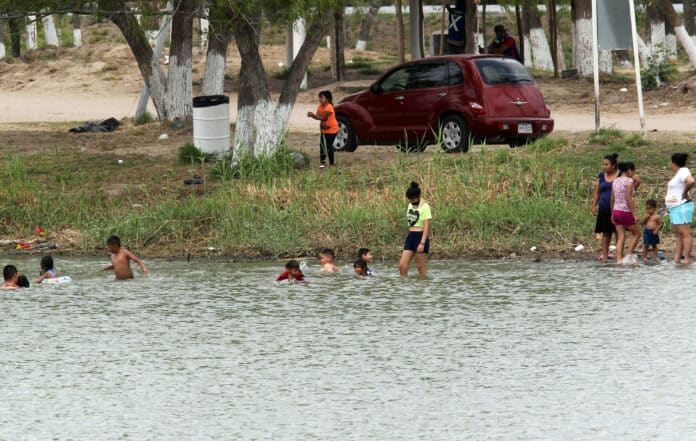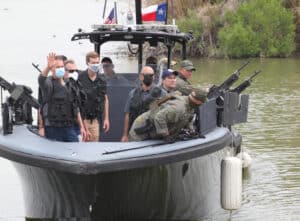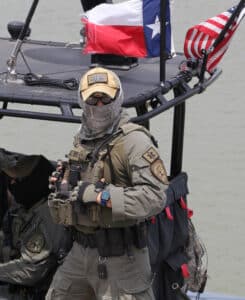
MISSION — There wasn’t much crisis to see at Anzalduas Park on Monday afternoon, but that doesn’t mean there wasn’t a whole lot of concern to be heard.

A bipartisan congressional delegation led by U.S. Rep. Vicente Gonzalez, D-Gonzalez, was at the park Monday in an effort to address those concerns — over migration at the southern border — through compromise.
The eight congressmen and sole congresswoman were greeted by warm weather, a river full of ducks and two gunboats moored to the dock, both bristling with machine guns.
“We’re here to solve problems,” Gonzalez said Monday. “We’re here to figure it out. We’re not here to score political points or point fingers at each other. We’re here to do the work of the American people, and I could not be more proud to be part of this group.”
On the American side of the Rio Grande, a man mowed grass in the park that didn’t look like it was in much need of being cut. A couple of families were playing on the Mexican side, kids splishing and splashing in the river water.
“Esta caliente,” one yelled across. Another differed, saying the water was cold. Either way, they looked like they were enjoying themselves.
The congressman boarded the boats for their tour on the opposite bank. A couple of ducks spooked and took off. The only migrant was a 2-foot rattlesnake, swimming up onto the north shore down river from the docks.
The congresspeople went up river and came back a while later to take questions from reporters.
That calm on the border, from the wildlife to the high-profile river cruises that have become an almost weekly occurrence, belie political and humanitarian turmoil.
Call it a crisis or call it an acceptable phenomena being executed poorly, there is certainly a situation on the southern border as thousands of migrants are heading to the Rio Grande Valley seeking asylum.

The welfare of those individuals is often in jeopardy, and exactly how to respond to their arrival is a political hot potato that dominates national news. The Valley once again finds itself in the national spotlight.
There is a problem on the southern border, those congresspeople standing on the Anzalduas Park dock said, and they hope to fix it.
The gist of their message was that compromise and collaboration are what’s necessary to solve America’s immigration problem. Members of the Problem Solvers Caucus, the congresspeople said it will take Democrats and Republicans reaching across the aisle to solve America’s immigration problem.
“Bipartisan delegation,” U.S. Rep. Brian Fitzpatrick, R-Pennsylvania, said. “That’s the message we need to be sending, because this is not a Democrat or Republican issue. This is something everybody cares about, with certain American ideals very much at stake, that we’re going to make sure we accomplish.”
The congresspeople commiserated with the migrants and families they’d met on their visit. They condemned coyotes and cartels, who they said are profiteering off pain and hardships. They complimented local law enforcement and local leadership.
By the time Monday’s boat ride rolled around, the delegation had visited detention centers and processing centers and respite centers.
Seeing the border first hand and meeting the flesh and blood people who are here is a necessary step in finding a solution to the immigration situation, U.S. Rep. Jimmy Panetta, D-California, said. Panetta described their visit as a fact-finding mission, saying a solution won’t be found overnight, but that it could be found — eventually — through education and cooperation.
“I’ve been to the border, this is my fifth trip to the border, and I’ve come away with the same conclusion each time, and it is that we need to have short term solutions in dealing with the border but long term solutions looking beyond the border,” he said, “looking into the countries, making sure that they play as well. That they help out as well.”
Among all the pledges and platitudes, incorporating other countries into the U.S.’s border solution was the most fleshed out plan the congresspeople discussed Monday. Gonzalez described it in detail.
“What I envision is having a processing center for migrants that are making this very treacherous trip from Central America, in Southern Mexico or on the border on the Guatemalan side,” he said. “Where people can show up in a very humane, first class facility, like what we have now here — or even better — and process there. And if they qualify for asylum, they can come to the country. And this is in safe zones, where we can guarantee their security of what they’re running from.”
Moving those facilities south will help migrants and hurt cartels, Gonzalez said, although he doesn’t see that step being the only solution. He said the border will need a framework of solutions, flexible and tweakable. Mostly, he said, fixing the border will take more problem solving and less arguing.

“Everybody knows that we have a problem, regardless of how people want to label it, I know that there’s debates on labels; I’m not gonna get into debates on labels,” he said. “I want to get into debates of how we’re gonna fix the problem in my district on our southern border, that’s impacting our country, that’s impacting our friends and neighbors to the south of us, and certainly all these people that are making these trips.”
The caucus members expressed their hope at making solutions happen. The Problem Solvers Caucus is bigger than it’s been before, they said. That factor coupled with a 50-50 split in the senate and a slim majority in the house means they’ve got a shot at compromise winning out.
Members of the delegation had flights to catch and they wrapped up the show around 1:30 p.m.
The ducks went back to floating, the man kept on mowing and the kids across the river splashed away.



